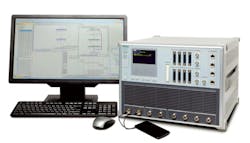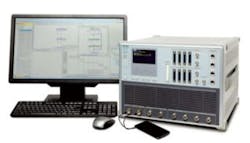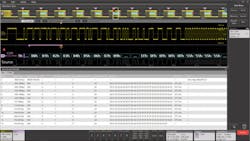Instrumentation vendors have been busy on a variety of communications-test and related fronts. Our two Special Reports in this issue look at a special class of instrumentation, vector network analyzers, and at a specific application area, high-speed digital technology.
Furthermore, companies including Rohde & Schwarz, Anritsu, and Tektronix have been addressing applications including 5G, cellular IoT, and automotive and aerospace communications buses. In addition, Spectrum Instrumentation has developed a software option for its digitizers that leverages GPU processing, and Tektronix has introduced a low-profile version of its 5 Series oscilloscope.
5G NR test and IoDT
Rohde & Schwarz announced it is enabling the testing and validation of sub-6-GHz 3GPP 5G New Radio (NR)-based devices with the latest version of the R&S CMW100 communications manufacturing test set, based on the R&S CMW platform.
The company said 3GPP’s 5G NR will support frequency ranges up to 52.6 GHz, but initial 5G designs will use frequencies below 6 GHz with a focus on 3.5 GHz. For these sub-6-GHz carrier frequencies, 3GPP currently discusses a maximum bandwidth per component carrier of 100 MHz. Thus, the R&S CMW100 communications manufacturing test set with a measurement bandwidth of 160 MHz is ready for testing initial 5G NR sub-6-GHz wireless devices, the company reported. Thanks to its high measurement speed, the R&S CMW100 is a suitable solution for high-volume production environments. The flexible testing solution can test many types of wireless devices, supporting LTE, WLAN, and Bluetooth besides 5G NR sub-6 GHz.
And in related 5G news, Qualcomm Technologies, ZTE, and China Mobile announced in November that they have successfully achieved what they call the world’s first end-to-end 5G NR Interoperability Data Testing (IoDT) system demonstrating a data connection based on 3GPP R15 standard. Following the guidelines of China Mobile, the IoDT connection demonstration took place at China Mobile’s 5G Joint Innovation Center and utilized ZTE’s 5G NR precommercial base station and Qualcomm Technologies’ 5G NR sub-6-GHz UE prototype.
The end-to-end 5G NR system operates at 3.5 GHz and supports a 100-MHz bandwidth, compliant with the 3GPP Release-15 5G New Radio layer 1 framework—including the scalable OFDM numerology, new advanced channel coding and modulation schemes, and the low-latency self-contained slot structure. The end-to-end 5G NR IoDT system is designed to efficiently achieve multigigabit-per-second peak data rates at significantly lower air-interface latency than 4G networks.
LTE and cellular IoT
Anritsu is addressing Gigabit LTE and cellular IoT test with the introduction of software options for its MD8430A signaling tester (Figure 1) that expand the LTE-Advanced Pro (LTE-A Pro) testing functions of the base-station simulator. With the new software options, the MD8430A supports Gigabit LTE and cellular IoT scenarios to create a comprehensive test solution that can efficiently verify LTE-A Pro-compliant chipsets and wireless devices.
Courtesy of Anritsu
The new functionality enables engineers to use the MD8430A to conduct Downlink 5 Carrier Aggregation (DL 5CA) and Uplink 3 Carrier Aggregation (UL 3CA) IP data-throughput tests of LTE-A Pro terminals. Effective communications speed tests under an SCME fading environment and Cat-M1 and NB-IoT protocol tests can also be conducted with the MD8430A base-station simulator when the new software is installed.
To lower cost-of-test and improve measurement efficiency, the MD8430A can output multiple base-station signals from one Tx antenna if all the signals are within the same band. This capability eliminates the need for multiple test sets even when Tx signals are increased due to additional component carriers.
Anritsu said the MD8430A base-station simulator supports the LTE-A Pro standard and is the centerpiece of a benchtop simulated network used to evaluate chipsets and data terminals during development. Built-in standalone fading functions allow the MD8430A to control fading in synchronicity with mobile communications tests to support LTE-A tests. It can be used with the Anritsu Rapid Test Designer (RTD) MX786201A software to establish a GUI for easy creation of test sequences for base station simulation in a MIMO environment.
Expanding scope application space
Tektronix is expanding the application space of its 5 Series mixed-signal oscilloscope technology into machine diagnostics and ATE with the introduction of the 5 Series MSO Low Profile model (Figure 2). The new model leverages the 5 Series scopes’ FlexChannel technology and 12-bit ADCs while offering a low cost per channel at 1-GHz bandwidth.
Courtesy of Tektronix
The company notes that conventional oscilloscopes used for machine diagnostics typically require 6U of rack space, whereas the 2U low-profile model offers a sixfold improvement in channel density at less than $5,000 per channel.
For ATE applications, the company said engineers can develop test programs using the original 5 Series with 15.6-inch display and then seamlessly transition to the rack-friendly low-profile version for manufacturing.
Tektronix is also expanding the application range of its 5 Series scopes with software options that address automotive and aerospace test as well as power analysis.
The new automotive options include the 5-SRAUTO protocol package, which offers complete serial triggering and analysis of the major buses used in the automotive industry, including CAN, CAN FD, LIN, and FlexRay. CAN FD support includes non-ISO and ISO versions of the standard. As shown in Figure 3, decoded CAN FD protocol information can be viewed as a time-correlated bus waveform (top) or in a tabular view (bottom).
Courtesy of Tektronix
In addition, the 5-CMAUTOEN Automotive Ethernet option provides automated compliance support for the IEEE P802.3bw (100BASE-T1) and BroadR-Reach V3.2 specifications. This automated compliance option includes test software that runs on the 5 Series MSO while performing Physical Media Attachment (PMA) transmitter Group 1 electrical measurement compliance tests, as defined by the OPEN Alliance Special Interest Group (SIG) standard for Automotive Ethernet.
For aerospace applications, 5-SRAERO option offers serial trigger and decode solutions for the most common serial buses used in the aerospace industry, including MIL-STD-1553 and ARINC 429.
In addition, the 5-PWR power measurement and analysis option enables designers to take advantage of the 5 Series MSO’s high channel count and 12-bit resolution to perform a range of automated power measurements and analysis including power quality, harmonics, switching loss, and safe operating area (SOA). Designers working with the latest GaN and SiC power semiconductors will be able to combine the 5 Series MSO, 5-PWR measurement option, and optically isolated IsoVu probes to enable multichannel, automated measurements of critical drive signals and switching voltages.
GPUs for digitizers
Spectrum Instrumentation is addressing a bottleneck in digitizer performance that can result from using either the host PC’s central processor with eight or 16 cores or an FPGA that is complex to program. Spectrum now offers its SCAPP (Spectrum CUDA Access for Parallel Processing) software option that opens a new way to digitize, process, and analyze
electronic signals.
The Spectrum approach uses a standard off-the-shelf GPU based on Nvidia’s CUDA standard. The GPU connects directly with the Spectrum digitizer card, opening the parallel core architecture of the CUDA card for signal processing. The structure of a CUDA graphics card fits well with digitizers, as it is designed for parallel data processing, at the heart of most signal processing jobs. For example, the processing tasks of data conversion, filtering, averaging, baseline suppression, FFT window functions, or even FFTs themselves can all be easily parallelized.
Spectrum reported that CUDA cards are scalable with processing cores between 256 and 5,000, with memory of several GB and up to 12.0 TFLOPS of compute performance. A small card with 1k cores and 3.0 TFLOPS is capable of doing continuous data conversion, multiplexing, windowing, FFT, and averaging at two channels at 500 MS/s with an FFT block size of 512k.
Readying for the 2020 Olympics
And finally, Rohde & Schwarz points out that in preparation for the Olympic Games 2020 in Tokyo, the Japanese broadcasting world is getting ready for 8K Ultra High-Definition TV (UHDTV), with public broadcaster NHK reportedly planning to roll out the needed ISDB-S3 standard in 2018. Rohde & Schwarz reports that in furtherance of the effort, SiTune Corp., a manufacturer of RF and mixed-signal semiconductors, silicon tuners enabling triple-play, and satellite and terrestrial/cable receivers, has successfully tested its tuners for 8K UHD satellite TV, in line with the emerging ISDB-S3 standard. The R&S SLG satellite load generator from Rohde & Schwarz generated the ISDB-S3 signals used in the test.
For more information:
About the Author

Rick Nelson
Contributing Editor
Rick is currently Contributing Technical Editor. He was Executive Editor for EE in 2011-2018. Previously he served on several publications, including EDN and Vision Systems Design, and has received awards for signed editorials from the American Society of Business Publication Editors. He began as a design engineer at General Electric and Litton Industries and earned a BSEE degree from Penn State.



